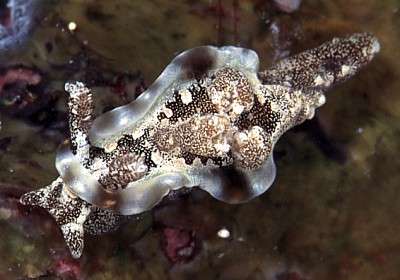
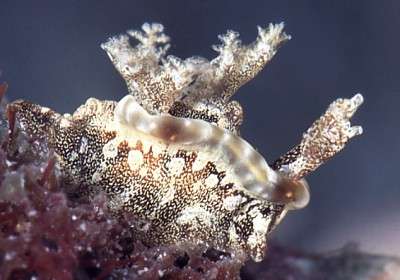
Goniodoris joubini
Risbec, 1928
Order: NUDIBRANCHIA
Suborder: DORIDINA
Superfamily: ANADORIDOIDEA
Family: Goniodorididae
DISTRIBUTION
Western Pacific from Japan to eastern Australia.
PHOTO
Kerama Is. near Okinawa, Japan. 5m depth, 7mm long. PHOTO: Atsushi Ono.
Originally described from New Caledonia as G. joubini it was later reported from Japan as
Goniodoris glabra Baba, 1937. It has also been recorded from Hong Kong (Rudman & Darvell, 1990 as G. glabra) and the Great Barrier Reef (Marshall & Willan, 2000 - as G. joubini). There is a good painting in Baba (1949) [Opisthobranchs of Sagami Bay].
The mantle and body are dark brown with white specks. There are some larger white or cream patches which often have yellow centres. There is a broad translucent band around the mantle edge which is sometimes spotted with yellow and dark brown (not here), Grows to about 20mm long alive. See message below for Risbec's original colour illustration.
See Scott Johnson's message suggesting Goniodoris aspersa Alder & Hancock, 1864 is the same species, and so the earliest name.
References:
• Alder, J. & Hancock, A. (1864) Notice of a collection of nudibranchiate mollusca made in India by Walter Elliot Esq., with descriptions of several new genera and species. Transactions of the Zoological Society of London, 5: 113-147.
• Risbec, J. (1928) Contribution a l'etude des nudibranches neo-caledoniens. 1-328. Faune des Colonies Francaises. Societe d'Editions geographique, maritimes etc coloniales: Paris
• Baba, K. (1937) Opisthobranchs of Japan. 2. Journal of the Department of Agriculture, Kyushu Imperial University, 5(7): 289-344.
• Baba, K. (1949) Opisthobranchs of Sagami Bay. Iwanami Shoten: Tokyo.
• Rudman, W.B. & Darvell, B.W. (1990) Opisthobranch Molluscs of Hong Kong: Part 1. Nudibranch Families; Goniodorididae, Onchidorididae, Triophidae, Gymnodorididae, Chromodorididae. Asian Marine Biology, 7: 31-79.
Rudman, W.B., 2000 (March 10) Goniodoris joubini Risbec, 1928. [In] Sea Slug Forum. Australian Museum, Sydney. Available from http://www.seaslugforum.net/find/gonijoub
Related messages
Goniodoris joubini found in sthrn Queensland
April 8, 2008
From: Gary Cobb
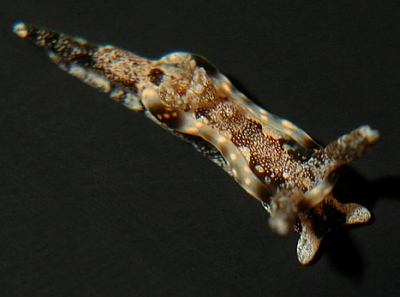
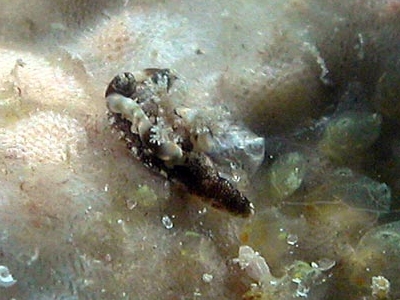
Hi Bill and everyone!
Here is another record from the Sunshine Coast. Goniodoris joubini yet again found at Old Woman Island. The in situ photo shows lots of possible food sources. Is one of them it?
Locality: Mooloolaba, Sunshine Coast, 12 m, Queensland, Australia, Pacific Ocean, 28 July 2007, Subtidal. Length: 9 mm. Photographer: Gary Cobb.
Cheers
Gary Cobb
gary@nudibranch.com.au
Cobb, G.C., 2008 (Apr 8) Goniodoris joubini found in sthrn Queensland. [Message in] Sea Slug Forum. Australian Museum, Sydney. Available from http://www.seaslugforum.net/find/20939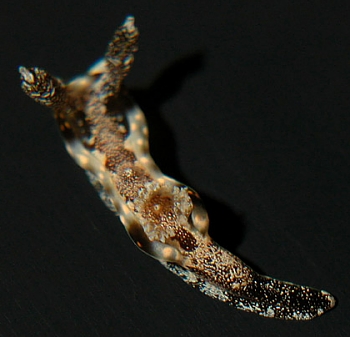
Dear Gary,
When I first looked at your photo I thought it was crawling on a dead Porites coral, but on a closer look the textured white background is a bryozoan colony. Some species of Goniodoris seem to feed exclusively on ascidians but others, such as Goniodoris nodosa, are reported to feed on both ascidians and encrusting bryozoans. It would be worth keeping a look out for where you find Goniodoris joubini, because it is possible it is one of the species which feeds on bryozoans.
Best wishes,
Bill Rudman
Goniodoris joubini from the in Red Sea
September 1, 2005
From: Martina Balzarova
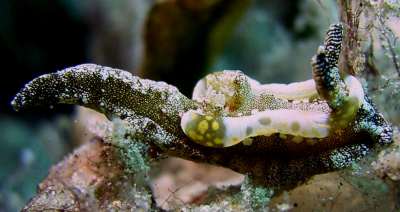
Hello Bill,
I have some photographs of a nudibranch I haven't seen before and can't identify. Please help me with the identification. I think that it is Elysia or Thuridilla sp. (Elysiidae),
Locality: Lighthouse, Dahab (Gulf of Aqaba) on Sinai Peninsula, Red Sea, Egypt. The bottom is sandy and there is a sea grass. Depth: 15 m. Length: 4 cm. 15 August 2005. 28 degrees, grass bottom. Photographer: Martina Balzarova.
Thanks a lot
Martina
seamaster@vol.cz
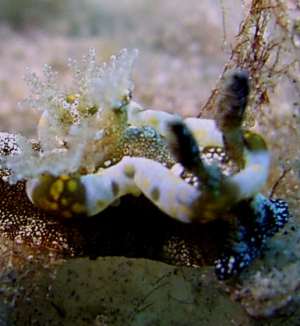
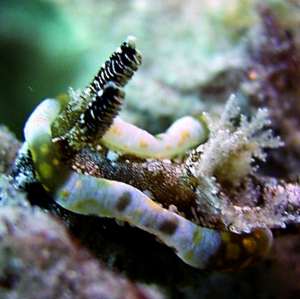
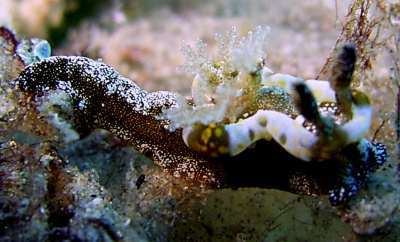
Dear Martina,
This is not an elysiid. The large circlet of gills on the back is a sure sign this is some sort of dorid nudibranch. Sacoglossans, such as Elysia don't have gills like this. I am pretty sure this is the species I am calling Goniodoris joubini on the Forum. Another name that has been used for it is Goniodoris glabra and to complicate things further, the oldest name is probably Goniodoris aspersa [see message #5699].
What they all have in common is the hign body profile and the inflated margin around the mantle edge. It almost looks like an inflated bike tire tube. Your animal has more yellow spotting than seen in Pacific specimens which is interesting because Alder & Hancock's original painting of G. aspersa from India shows yellow spots like this. This is the first record I know of it from the western Indian Ocean.
Best wishes,
Bill Rudman
Goniodoris aspersa in the Marshall Islands
October 22, 2002
From: Scott Johnson
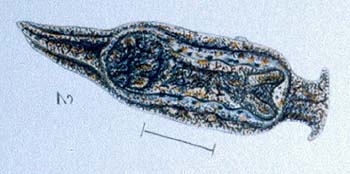
Hi Bill,
Here is what may be another form of Goniodoris joubini from the Marshalls. It is similar to the other color form, but is more white rather than yellowish in the background and is more blotched with black, especially in the larger specimen, which measured about 12mm.
I also included a scan of Alder & Hancock's drawing of a Goniodoris they described as G. aspersa in 1864 [Plate 33, fig. 2]. Do you know what the status of this name is? Cannot really tell too much from the picture, but it looks like it could be G. joubini.
• Alder, J. & Hancock, A. (1864) Notice of a collection of nudibranchiate mollusca made in India by Walter Elliot Esq., with descriptions of several new genera and species. Transactions of the Zoological Society of London, 5: 113-147.
Scott
johnson@kmr.ll.mit.edu
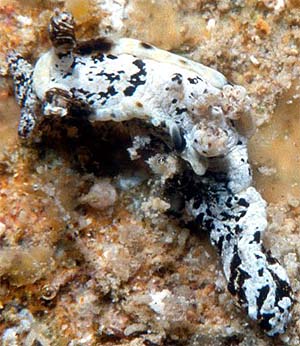
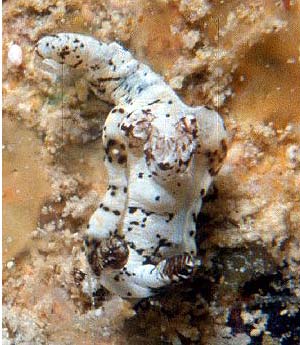
Dear Scott,
I think you are right. I also had a look at my notes on Alder & Hancock's species and see that I had, at some time, written G. glabra? alongside their name. It seems pretty clear to be that G. aspersa is the oldest name for G. glabra and G. joubini. It would be interesting to compare the anatomy of specimens from India, where G. aspersa was described from, with western Pacific animals.
Best wishes,
Bill Rudman.
Goniodoris joubini? from Japan.
July 30, 2002
From: Jun Imamoto
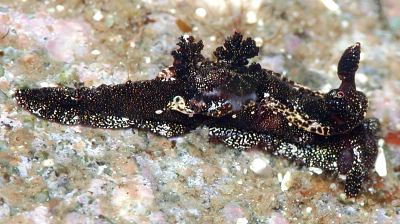
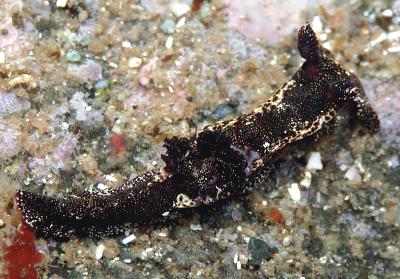
Dear Bill.
I went diving at Wakasa Bay, Echizen-coast, Japan on July 10. I found this sea slug for the first time in this place. I think it is perhaps a species of Goniodoris, perhaps Goniodoris joubini? I would be very happy if you could comment.
Date: 10 July 2002
place: Echizen-coast Wakasa Bay, Japan
size: about 18mm
depth: 4 m
temperature: 23 C
Best Regards,
Jun Imamoto
imamoto@wips.co.jp
Imamoto, J., 2002 (Jul 30) Goniodoris joubini? from Japan.. [Message in] Sea Slug Forum. Australian Museum, Sydney. Available from http://www.seaslugforum.net/find/7546Dear Jun,
I am pretty sure this is the dark form of G. joubini which used to be caled G. glabra in Japan.
Best wishes,
Bill Rudman
Goniodoris joubini with egg ribbon
May 1, 2002
From: Scott Johnson
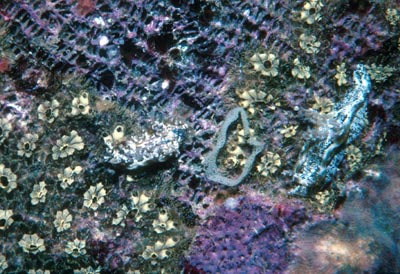
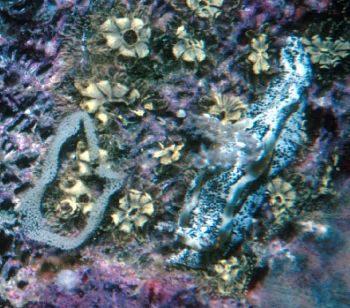
Hi Bill,
To accompapy of my other message here is a photo of what appear to be a pair of typical Goniodoris joubini with an egg mass on a colonial tunicate that may have been the nudibranchs' prey.
Scott
johnson@kmr.ll.mit.edu
Johnson, S., 2002 (May 1) Goniodoris joubini with egg ribbon. [Message in] Sea Slug Forum. Australian Museum, Sydney. Available from http://www.seaslugforum.net/find/5960Thanks Scott,
Bill Rudman
Goniodoris joubini in the Marshall Islands
May 1, 2002
From: Scott Johnson
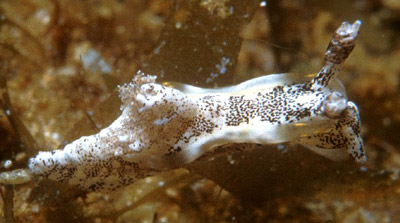

Hi Bill,
Up until recently, I've assumed that there was only one species of Goniodoris in the Marshall Islands. It was only after a friend pointed out that there seemed to be some pretty consistent differences in my photos that I began to question that assumption. I'll send the photos of the ones I thnk are different in a separate message. Attached to this message are photos of what appear to be typical Goniodoris joubini. In another message is a photo showiing a pair of 'true' G. joubini with an egg mass on a colonial tunicate that may have been the nudibranchs' prey.
Scott
johnson@kmr.ll.mit.edu
Johnson,S., 2002 (May 1) Goniodoris joubini in the Marshall Islands. [Message in] Sea Slug Forum. Australian Museum, Sydney. Available from http://www.seaslugforum.net/find/5697Thanks Scott,
Bill Rudman.
Goniodoris joubini from Hong Kong
February 6, 2002
From: Bill Rudman & Brian Darvell

Here is some information and photos on Goniodoris joubini from Brian Darvell's Hong Kong collections.
Characterized by the brown mantle covered in white specks. Around the edge of the mantle is a translucent white band spotted with yellow and dark brown. The foot and sides of the body are dark brown with white speckling. Japanese specimens have been reported to grow to 20 mm long (Abe 1964) and Hong Kong specimens were 14 mm long preserved. Previously identified as G. glabra it is now considered synonymous with G. joubini Risbec, 1928 which was described from New Caledonia (Risbec 1928: 175-77, fig. 52, pl. 5, fig. 2) and more recently reported from Australia (Willan and Coleman 1984: 18-19).
PHOTO:
AM C139213, 14 April 1983, Site 2.32, Round Is. (E), Mirs Bay, 3-10 m, Hong Kong.
Hong Kong Collection Records:
AM C139212, 1 April 1983, Site 4.60, Kong Chau (NW), Mirs Bay, 5-10 m. AM C139213, 14 April 1983, Site 2.32, Round Is. (E), Mirs Bay, 3-10 m. AM C150306, 8 April 1986, Site 8.69, Long Ke Wan (N), intertidal. AM C150307, 14 April 1986, Site 4.8, Breaker Reef, Mirs Bay, 5 m. Depth range: 0-10m.
Reference:
• Rudman, W.B. & Darvell, B.W. (1990) Opisthobranch molluscs of Hong Kong. Part 1. Goniodorididae, Onchidorididae, Triophidae, Gymnodorididae, Chromodorididae, (Nudibranchia). Asian Marine Biology, 7: 31-79
Best wishes,
Bill Rudman & Brian Darvell
Goniodoris joubini from Japan
May 14, 2000
From: Yasuhiro Shirai
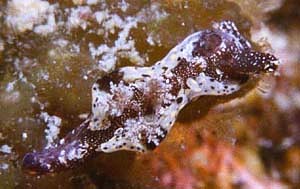
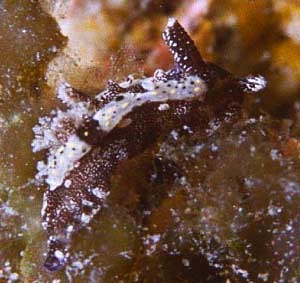
Dear Bill,
Here are two photos of the same individual. I think that the rhinophore of this animal has been lost in one side. I think this animal is Goniodoris glabra or Goniodoris joubini.
Could you please identify it for me?
Data:
Location: Shima Pref. Mie Japan
Length: 10mm
Water temperature: 15C
Date 2000.02.14
Depth: -2m
Crawling on seaweed
Best regards,
Yasuhiro Shirai
yasuhiro@e-net.or.jp
Shirai, Y., 2000 (May 14) Goniodoris joubini from Japan. [Message in] Sea Slug Forum. Australian Museum, Sydney. Available from http://www.seaslugforum.net/find/2383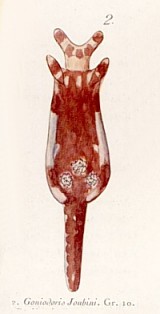
Dear Yasuhiro,
Goniodoris joubini from New Caledonia and Goniodoris glabra from the NW Pacific are almost certainly the same species.
Up until now I have continued using the name Goniodoris glabra for Japanese material because the only similar animal I had from New Caledonia, which I assumed was G. joubini, was dark brown with white speckling, and without any sign of yellow, which made it rather different from Baba's description. However Marshall & Willans's photo of an animal from the Great Barrier Reef, identical in colour to Japanese specimens, shows that the species is widespread. Risbec in his description, but not in the published painting [which I reproduce alongside], mentions yellow spots on the dorsum and orange yellow spots around the edge.
I think there is not much doubt that the two names apply to the same species, the oldest name being Goniodoris joubini Risbec, 1928.
Best wishes,
Bill Rudman.
Gonidodoris glabra? from Kerama Is.
April 3, 2000
From: Atsushi Ono
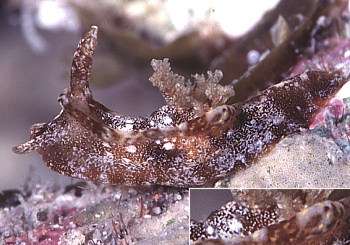

Dear Bill,
Thank you for your comments on Polycera? sp.6.
I think these photos are Goniodoris glabra . This animal is very similar to the picture in "OPISTHOBRANCHIA OF SAGAMI BAY".
This color form is of original description of G. glabra, isn't it ?
This is 10mm long, found at 10m depth, on the rope covered with algae, sponges, Hydrozoa and Bryozoa at Kerama Is. near Okinawa in Japan.
Sincerely,
Atsushi Ono
ononini@cosmos.ne.jp
Ono, A., 2000 (Apr 3) Gonidodoris glabra? from Kerama Is.. [Message in] Sea Slug Forum. Australian Museum, Sydney. Available from http://www.seaslugforum.net/find/2191Dear Atsushi,
Yes I think these photos are of Goniodoris glabra. They differ only slightly from the earlier photos you sent which I also identified as this species. There is a slight possibility they are different but I would need to look at their anatomy to be sure.
The original description of this species was not in Opisthobranchs of Sagami Bay but in a much earlier paper. I have added to the references at the top of the page. The yellow spots around the mantle edge mentioned in Baba's description are clearly visible in these animals (see inset).
Best wishes,
Bill Rudman.
Goniodoris glabra from Japan
March 12, 2000
From: Atsushi Ono


Dear Bill,
Thank you for ID of Melibe engeli.
This time, I attach a Goniodoris species. This is similar to G.felis in its form, but different in color. There are many milky-white dots on it's body, rhinophores and gills.
I found this animal at 5m depth on a rock at Kerama Is. near Okinawa. Its size is 7mm long.
This is very rare species, I have ever seen only one individual.
Could you help me to identify this?
Sincerely,
Atsushi Ono
ononini@cosmos.ne.jp
Ono, A., 2000 (Mar 12) Goniodoris glabra from Japan. [Message in] Sea Slug Forum. Australian Museum, Sydney. Available from http://www.seaslugforum.net/find/2064Dear Atsushi,
This is Goniodoris glabra Baba, 1937 which was originally described from Japan. There is a good painting in Baba (1949) [Opisthobranchs of Sagami Bay].
Best wishes,
Bill Rudman.
